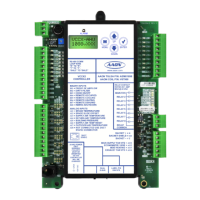27VCCX2 Controller Technical Guide
INPUTS AND OUTPUTS
VCCX2 Controller Inputs/Outputs Descriptions
BI5 - Remote Forced Cooling Mode Input
A wet contact closure on this input is used to provide a means for
another building automation system or control device (by others)
to force the unit into Cooling Mode.
BI6 - Remote Forced Heating Mode Input
A wet contact closure on this input is used to provide a means for
another building automation system or control device (by others)
to force the unit into Heating Mode.
BI7 - Remote Forced Dehumidication Input
A wet contact closure on this input is used to provide a means for
another building automation system or control device (by others) to
force the VCCX2 Controller into Dehumidication Mode.
NOTE: If remote forced operation is used, it must apply to
Cooling, Heating, and Dehumidication. The unit
must be congured for Mode Set By Remote Contact.
BI8 - Emergency Shutdown Input
This wet contact input is used to initiate shutdown of the HVAC
unit when a normally closed smoke detector (by others), restat (by
others), or other shutdown condition (by others) contact is opened.
The controller remains active and can initiate alarm relays.
NOTE: The binary inputs require wet contacts (24 VAC only)
to recognize an active input. If only dry contacts are
provided, the contact closure is not be recognized. All
binary inputs are optional. This means the VCCX2
Controller must be congured to recognize these input
signals.
Analog Outputs
AO1 - Main Supply Fan VFD Control Signal or Bypass Damper
Control Signal
This user-adjustable voltage signal is used to modulate the supply
fan VFD in VAV, single zone VAV, lter loading applications, or
reverse acting building pressure control using the VFD. In a volume
and variable temperature zoning application, this output is used to
control a bypass damper.
AO2 - Outdoor Air Damper Economizer Control Signal or
Waterside Economizer Valve Signal
Outdoor Air Damper Economizer Control Signal
This user-adjustable voltage signal is used to control the outdoor air
damper during economizer operation. It is also used to maintain the
outdoor air damper at its minimum position during Occupied Mode
when the outdoor air temperature is not suitable for economizer
cooling purposes. This minimum position can be reset based on
CO
2
override conditions.
This output is also used to control the outdoor air damper based on
an Outdoor Airow Setpoint if using an outdoor airow monitoring
station. This position can be overridden during economizer control.
Finally, this output can be used to control the outdoor air damper
during reverse acting building pressure control to maintain a
Building Pressure Setpoint.
Waterside Economizer Valve Signal
This 2-10 VDC signal is used to modulate the waterside economizer
valve during waterside economizer operation.
AO3 - Modulating Heat Control Signal
This output can be congured with a user-adjustable voltage range
of operation which can be set up to provide either a direct or reverse
acting operation. This output is used to operate a Modulating
Heating Device to maintain the Heating Supply Air Setpoint during
the Heat Mode of operation.
AO4 - Exhaust Fan VFD Signal / Building Pressure Control
Signal
This user-adjustable voltage signal is used to provide direct acting
building pressure control using an exhaust fan VFD or a modulating
exhaust damper.
NOTE: For reverse acting building pressure control using the
outdoor air damper or supply fan VFD, the VCCX2
Controller uses the outputs specic to those devices.
On the main VCCX2 Controller, AO2 controls the
outdoor air damper and AO1 controls the supply
fan VFD to maintain the Building Pressure Setpoint.
Alternatively, this AO4 output will mirror those
outputs and can be used as well.
Relay Outputs
RLY1 - Supply Fan (Enable)
This is a non-congurable output.
RLY2-RLY8 - User-Congurable Relays
These relays are congurable by the user. See Table 10, page 29.

